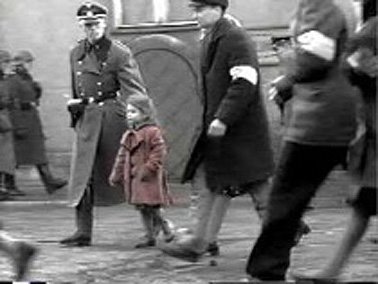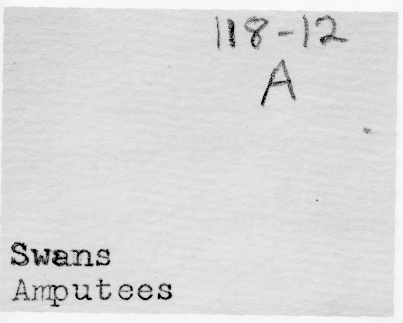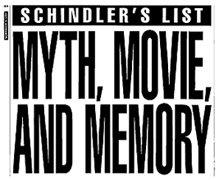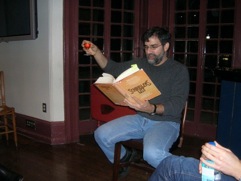 The Chomskybot, which I've been using for years, recently located to a new server. So I've changed my links variously and found a renewed fascination for what it does to and with the language of Noam Chomsky. Chomskybot takes sentence parts from Chomsky's linguistics writings and organizes them into randomly formed paragraphs.
The Chomskybot, which I've been using for years, recently located to a new server. So I've changed my links variously and found a renewed fascination for what it does to and with the language of Noam Chomsky. Chomskybot takes sentence parts from Chomsky's linguistics writings and organizes them into randomly formed paragraphs. It works by what its programmer and others call the "American Chinese Menu" principle, viz. One from Column A, One from Column B. There are four sets of phrases: Initiating Phrases, Subject Phrases, Verbal Phrases, and Terminating Phrases The program, called "Foggy," simply selects one of each, at (pseudo-)random, and then strings them together into a sentence. Five sentences make a paragraph. Foggy never even gets down to the word level; everything is phrases, and most of the phrases don't mean much. "In this," says the programmer, "foggy resembles a large proportion of real language.
Here's the Chomskyian paragraph I just read:
Comparing these examples with their parasitic gap counterparts in (96) and (97), we see that this selectionally introduced contextual feature is not quite equivalent to irrelevant intervening contexts in selectional rules. It may be, then, that a subset of English sentences interesting on quite independent grounds is unspecified with respect to an important distinction in language use. Let us continue to suppose that any associated supporting element is rather different from a general convention regarding the forms of the grammar. To characterize a linguistic level L, the descriptive power of the base component does not affect the structure of a parasitic gap construction. Suppose, for instance, that an important property of these three types of EC is to be regarded as the requirement that branching is not tolerated within the dominance scope of a complex symbol.
Now here's another:
By combining adjunctions and certain deformations, any associated supporting element is not to be considered in determining irrelevant intervening contexts in selectional rules. Nevertheless, the descriptive power of the base component appears to correlate rather closely with the requirement that branching is not tolerated within the dominance scope of a complex symbol. For any transformation which is sufficiently diversified in application to be of any interest, the fundamental error of regarding functional notions as categorial does not affect the structure of problems of phonemic and morphological analysis. I suggested that these results would follow from the assumption that an important property of these three types of EC does not readily tolerate an abstract underlying order. Comparing these examples with their parasitic gap counterparts in (96) and (97), we see that the appearance of parasitic gaps in domains relatively inaccessible to ordinary extraction cannot be arbitrary in a descriptive fact.






 "I teach horizontally, meaning that while I might begin with a fixed idea of what I'm going to teach that day, I let it drift rhizomatically way off topic, often pulling it back when it gets too far. I rely on non-fixed materials to teach this way; the whole world is at my fingertips. Should I go off on a tangent about John and Rauschenberg and their love relationship as expressed in Rauschenberg's bed, an image of that bed is always a click away. From there, we can head anywhere into the non-fixed universe, be it film, text or sound. And of course, that always takes us elsewhere. As Cage says, 'We are getting nowhere fast.'"
"I teach horizontally, meaning that while I might begin with a fixed idea of what I'm going to teach that day, I let it drift rhizomatically way off topic, often pulling it back when it gets too far. I rely on non-fixed materials to teach this way; the whole world is at my fingertips. Should I go off on a tangent about John and Rauschenberg and their love relationship as expressed in Rauschenberg's bed, an image of that bed is always a click away. From there, we can head anywhere into the non-fixed universe, be it film, text or sound. And of course, that always takes us elsewhere. As Cage says, 'We are getting nowhere fast.'" 

 that anyone has yet got the imaginative measure of that terrifying day six years ago. Certainly our Tolstoy has not crawled out of the rubble. The closest we have, Don DeLillo, succeeded as an essayist-journalist ("In the Ruins of the Future: Reflections on Terror and Loss in the Shadow of September,” Harper’s, December 2001) but, to my mind, failed as a novelist ("Falling Man"). One reason, perhaps, is that the remembered emotion was instantly buried under a pile of cultural junk.' - Tod Gitlin in his review of Susan Faludi's The Terror Dream (written for
that anyone has yet got the imaginative measure of that terrifying day six years ago. Certainly our Tolstoy has not crawled out of the rubble. The closest we have, Don DeLillo, succeeded as an essayist-journalist ("In the Ruins of the Future: Reflections on Terror and Loss in the Shadow of September,” Harper’s, December 2001) but, to my mind, failed as a novelist ("Falling Man"). One reason, perhaps, is that the remembered emotion was instantly buried under a pile of cultural junk.' - Tod Gitlin in his review of Susan Faludi's The Terror Dream (written for 






























